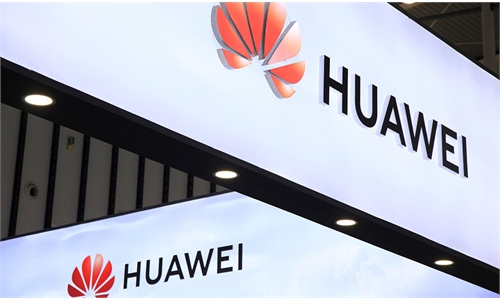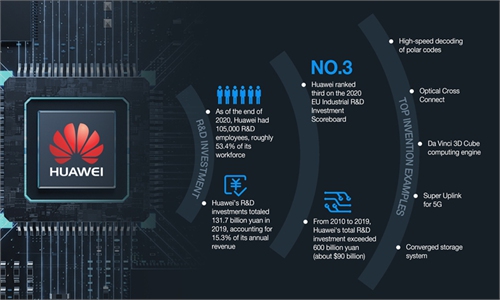SOURCE / PRESS RELEASE
Huawei smart PV: injecting momentum into Xihaigu’s rural rejuvenation
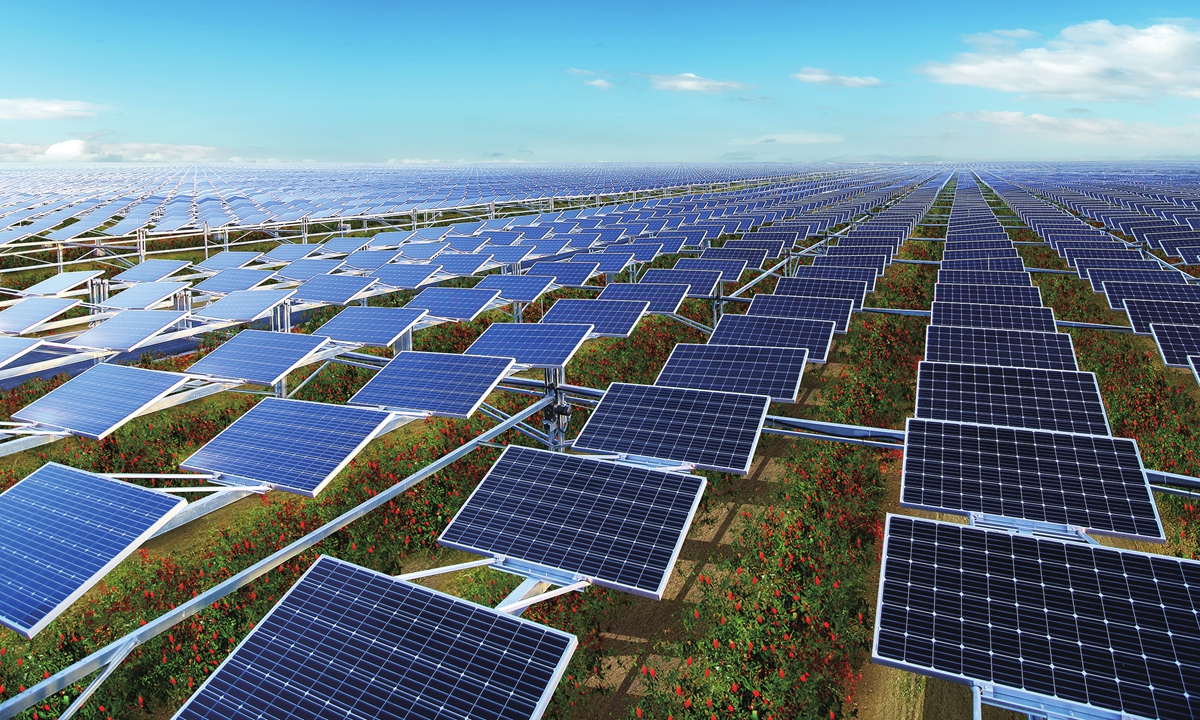
Agriculture and PV integrated industrial base Photos: Courtesy of Huawei
In early spring, sunshine falls over the long stretch of desert across the foothill of the Helan Mountains in Northwest China's Ningxia Hui Autonomous Region, turning the barren landscape yellow. But unlike years ago, it's now also colored with blue photovoltaic (PV) panels and white windmills.Thanks to the PV industry and smart technologies, residents in Xihaigu - a region made up of six counties in south Ningxia, historically and even internationally known for its harsh environment- have turned disadvantages into advantages by increasing incomes via natural resources, and are marching toward rural rejuvenation after shaking off poverty.
As the country's first new energy demonstration zone, Ningxia greatly boosts the development of the PV industry by making the most of its local advantages of high altitude, long sunshine hours and strong radiation. At the same time, the region actively explores ways to fight against poverty through developing the PV industry. It has now built 345 village-level PV stations for poverty alleviation, with an estimated total scale of 119,000 kilowatts. They are expected to generate revenues of about 100 million yuan ($15.29 million) every year, which will be used for poverty alleviation programs that will benefit more than 26,000 impoverished households.To ensure the stable operation of these PV stations for the long-term benefits of villagers, Ningxia is adhering to high standards in choosing equipment and adopting the most advanced of Huawei's smart PV solution through open tender.
With smart operation and maintenance methods such as cloud computing, wireless broadband system and unmanned drone patrolling and checking, Huawei's smart PV solution can effectively resolve a range of difficulties such as small capacity of plants and wide distribution so as to realize long-distance monitoring, checking and managing of these village-level PV stations.
Compared with traditional methods, Huawei's smart PV solution raises power generation by over 3 percent, and operation and maintenance efficiency by over 50 percent. With precision poverty relief measures like these, Huawei is helping impoverished regions enjoy long-term stable material benefits brought about by technologies and clean energy as poor regions march toward rural rejuvenation after shaking off poverty.
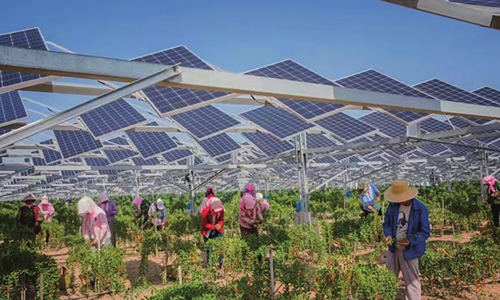
Farmers pick lycium barbarum. Photos: Courtesy of Huawei
PV stations help villagers get rich
The main battlefield against poverty in Xihaigu, Hongde village in Hongsibu township, is the country's largest poverty alleviation relocation site for ecological migration, with a total of 7,206 residents migrating from 27 villages since 2012.
Entering the village, vineyard, vegetable greenhouses, PV power stations, cattle farm and industrial park come into sight, and large teaching buildings, health centers and environmentally friendly vehicles stand out clearly. Some villagers plant trees around their houses, some build houses, and village cadres are especially busy… the whole village is a scene of vigor and striving for a better life.
"Capacious and smooth… We live in houses built with bricks and drink safe tap water. There is a school and hospital and it's also convenient to go to market," Xi Jinlong said, with happy smile on his face.
Xi migrated to the village in 2012 from Xihaigu. In Xihaigu, what Xi saw every day was drought-ridden and barren land, where he lived in a house built of earth and drank bitter, salty water. Due to limited education resources, he was unable to go to college and leave the barren land. Thanks to poverty alleviation relocation, Xi left Xihaigu and now has his own house, job and new family.
As Xi was unable to do heavy physical work, the village committee arranged a public welfare position of cleaning the PV park and panels in the village, a job that earns him about 1,100 yuan a month.
In fact, Xi's work is covered by the village's collective income, of which local PV power stations are an important source. In Hongde, there are two PV power stations for the poverty-relief project - one was built in 2015 and the other was built during the 13th Five-Year Plan Period (2016-20), generating a combined revenue of 350,000 to 400,000 yuan each year. Liu Keyin, vice secretary of the Party branch of Hongde, said that the PV power stations have generated stable incomes for the village for the last three years, and are used to provide public welfare positions for villagers like Xi as well as support disadvantaged groups, college students, and villagers that have serious illnesses.
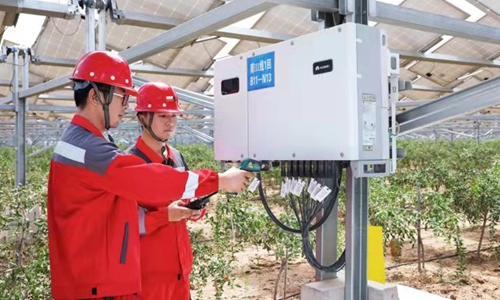
Engineers check a Huawei smart inverter. Photos: Courtesy of Huawei
Huawei's smart PV solution
It's worth mentioning that the PV power stations in Hongde village adopt Huawei's smart string inverter and the company's fully digitized smart PV solution. Yan Jianfeng, a technician from Huawei's smart PV department, said that poverty-relief projects have three core requirements: reliable product quality to ensure these projects generate revenue for at least 20 years, long-term service capability and ability to be updated and lower maintenance frequency to keep costs down.
In carrying out the programs, poverty relief office staff members were impressed by three factors. The quality of Huawei products is guaranteed and they have a low failure rate. Huawei solar inverters passed more than 1,400 tests, including lighting and anti-explosion tests.
Based on artificial intelligence technology and algorithms, Huawei's smart PV solution can precisely detect laggard PV strings so as to diagnose, check and receive PV power stations. In addition, Huawei's system is simple and does not have vulnerable components.
As a result, it requires no daily maintenance apart from some basic work such as weeding and cleaning panels, which makes it easy to provide jobs for impoverished households. Yan calculated that Huawei's smart PV solution is able to generate an extra 7.2 million yuan over 20 years compared with traditional solutions. "To make PV a major energy source, the core is to solve the problem of energy storage while cutting costs through technologies," he said.
Huawei has more than 10 years of experience in R&D of energy storage and has accumulated rich experience in energy storage applications in communication sites, data center and car power.
Zhou Taoyuan, president of Huawei's Digital Power Product Line, recently said that Huawei will continue to strengthen R&D investment in a bid to strive for innovations with partners and bring green power to households and industries to boost carbon neutrality.

